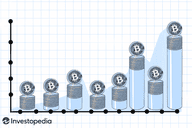What Is a Descending Triangle?
A descending triangle is a chart pattern used in technical analysis created by drawing one trend line connecting a series of lower highs and a second horizontal trend line connecting a series of lows.
A regular descending triangle pattern is commonly considered a bearish chart pattern or a continuation pattern with an established downtrend. However, a descending triangle pattern can also be bullish, with a breakout in the opposite direction, and is known as a reversal pattern.
Key Takeaways
- A descending triangle signals traders to take a short position to accelerate a breakdown.
- A descending triangle is detectable by trend lines drawn for the highs and lows on a chart.
- A descending triangle is the counterpart of an ascending triangle, another trend line-based chart pattern used by technical analysts.
What Does a Descending Triangle Tell You?
A popular chart pattern used by traders, descending triangles clearly show that demand for an asset, derivative, or commodity is weakening. When the price breaks below the lower support, it indicates that downward momentum is likely to continue.
Technical traders have the opportunity to make substantial profits over a brief period. They often watch for a move below the lower support trend line, suggesting that downward momentum is building and a breakdown is imminent. Traders often enter into short positions to further lower the asset's price.
How to Identify a Descending Triangle
The descending triangle is one of three triangle patterns used in technical analysis.
:max_bytes(150000):strip_icc()/Triangles_AShortStudyinContinuationPatterns2_2-bdc113cc9d874d31bac6a730cd897bf8.png)
Image by Julie Bang © Investopedia 2019
A descending triangle pattern has the following features:
- An existing downtrend before the descending triangle pattern appears.
- A descending upper trendline can be drawn by connecting the upper points and indicates that the sellers are pushing prices downward.
- The lower horizontal trendline acts as support as prices approach this level until the breakout occurs.
- The downward trend continues after the breakout and is evident below the lower trendline.
How to Trade a Descending Triangle
Traders often initiate a short position following a high volume breakdown from lower trend line support in a descending triangle chart pattern.
In general, the price target for the chart pattern is equal to the entry price minus the vertical height between the two trend lines at the time of the breakdown. The upper trend line resistance also serves as a stop-loss level for traders to limit their potential losses.
Traders often choose the simplest way to use the descending triangle pattern and buy the breakout of the triangle, and it is one of several common strategies to take profits using this pattern.
Descending Triangle Pattern Breakout Strategy
This strategy anticipates a breakout from the descending triangle pattern and uses a combination of trading volumes and asserting the trend to capture short-term profits. When a stock is in a downtrend or a consolidation phase, traders watch for lower highs and lower lows being formed.
Descending Triangles With Heikin-Ashi Charts
Heikin-Ashi charts can apply to any market and are a trading tool used in conjunction with technical analysis to assist in identifying trends. The Heikin Ashi candlesticks turn bullish before the breakout. In this strategy, traders watch for the descending triangle pattern to form and wait for the bullish trend to begin using the Heikin Ashi charts.
Descending Triangle With Moving Averages
Traders can combine price techniques, like the moving average, and chart patterns with technical indicators. In this strategy, traders use the descending triangle pattern to anticipate potential breakouts, and the moving average indicators trigger the signal to initiate a trade.
Descending Triangle Reversal Pattern—Top
This pattern emerges when volume declines and new stock price highs are limited. The pattern indicates that the bullish phase is ending. The trading period begins when the descending triangle reversal pattern is revealed ahead of the breakout.
Descending Triangle Reversal Pattern—Bottom
The descending triangle reversal pattern at the bottom end of a downtrend is where the price action stalls and a horizontal support level mark a bottom. If the price action breaks to the upside from the descending triangle reversal pattern at the bottom, a trader can choose long positions.
Descending Triangles vs. Ascending Triangles
Both the ascending and descending triangle are continuation patterns. The descending triangle has a horizontal lower trend line and a descending upper trend line. The ascending triangle has a horizontal trend line on the highs and a rising trend line on the lows.
Triangles reveal an opportunity to short and suggest a profit target, so both triangles are just different takes on a potential breakdown. Ascending triangles can also form at the reversal of a downtrend but are more commonly viewed as a bullish continuation pattern.
The Limitations of a Descending Triangle
Since no chart pattern is perfect and analysis is often subjective, using descending triangles has limitations. A false breakdown may occur, or trend lines may need to be redrawn if the price action breaks out in the opposite direction. If a breakdown doesn't occur, the stock could rebound to re-test the upper trend line resistance before making another move lower to re-test lower trend line support levels. The more often that the price touches the support and resistance levels, the more reliable the chart pattern.
What Is Descending Triangle Breakout?
Descending triangles are a bearish pattern that anticipates a downward trend breakout. A breakout occurs when the price of an asset moves above a resistance area, or below a support area.
What Is the Difference Between Breakdown and Breakout In Technical Analysis?
A breakout refers to price movement above a resistance area or below a support area. Breakouts indicate the potential for the price to start trending in the breakout direction. A breakdown is a downward move in a security's price, usually, through an identified level of support, that predicts further declines.
What Is the Difference Between Descending Triangle and Falling Wedge?
The falling wedge appears in a downtrend and indicates a bullish reversal. A descending triangle appears after a bearish trend with a probable breakdown continuation. The falling wedge appears in a downtrend but indicates a bullish reversal.
The Bottom Line
The descending triangle is a chart pattern used in technical analysis. The pattern usually forms at the end of a downtrend but can also occur as a consolidation in an uptrend. A regular descending triangle pattern is commonly considered a bearish chart pattern with an established downtrend. A descending triangle pattern, however, may be bullish, with a breakout in the opposite direction, known as a reversal pattern.


